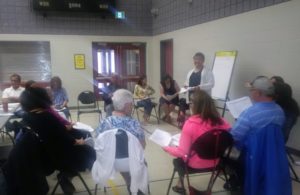‘We’re leaving a big footprint in education’ says Chief Thomas on the AES

By Laura Barrios
NIPISSING FIRST NATION— The Regional Education Council representatives from the communities moving forward with the Anishinabek Education System met on June 19 and 20, to further the development of the Anishinabek Education System in preparation for its effective date on April 1, 2018.
“This is the very first Regional Education Council meeting, so I think it’s a good opportunity to bring everyone back together post-ratification vote to identify the priorities and get through all of the important documents,” expressed Evelyn Ball, Assistant First Nation Manager of Rama First Nation, as well as the Secretary on the Kinoomaadziwin Education Body (KEB) Board of Directors. “It will be good to put what was proposed into actual action. It’ll take time because we all want to step lightly so we can be confident in where we’re going. I think there’s still a lot of work ahead as we come to April 1, 2018, but we’re all here for the same purpose which is the future of our students and those affected by the AES.”
19 communities from the four Regional Education Councils (RECs) represented by 45 participants, along with the KEB Board of Directors, were in attendance at the meeting held at Nbisiing Secondary School on Nipissing First Nation.
A portion of the meeting consisted of having the participants break out into their respective regions to come to decisions tailored to address their local education needs.
“I’m quite impressed with how our communities are coming together and just sorting things out as we go along. We’ve had a chance to develop a number of organizations…and bring our communities up to a better standard than before,” noted Judy Desmoulin, Councillor in Long Lake #58 First Nation. “There’s always work to do and improvements to be made, but…with all of the experts in the room and the high knowledge, we’re able to make a better system. It’s my desire that all of our First Nations get that control over education. You can solve so many community issues by having that local control.”
The meeting allowed for participants to provide direct input into the Anishinabek Education System structures, the RECs, staff, and workplans.
“This meeting is very important because we’re still in the developmental stages and there is still a lot of work has to be done to structure our own education system,” stated Chief Barron King of Moose Deer Point. “But we’ll get there—we’re getting there.”
Desmoulin brought two youth from the community to listen, learn and participate in the meeting in hopes of broadening their view of the world and providing a different perspective and input to the meeting.
“Part of our community strategy is to make sure that the youth are here having the same experiences,” stated Desmoulin. “These young people get to see how this is getting off of the ground. They were excited!”
Other points of discussion included the current status of the Data Information and Sharing Agreement and Multi-Year Action Plan with Ontario. The Multi-Year Action Plan sets up the work in the first three years at two levels – the Kinoomaadziwin Education Body and Ministry of Education level and the First Nation and Provincial School Board level.
The participants also received updates on the signing ceremony that is scheduled later this summer on August 16, in Chippewas of Rama First Nation. The community will be host to the historic signing of the Anishinabek Nation Education Agreement with the Government of Canada and Master Education Agreement with the Province of Ontario.
The meeting provided an opportunity for the communities to vocalize any questions, comments, or points of concern in relation to the next steps in the transition to the AES.
“This meeting was very good—the individuals involved in structuring the KEB and AES are very intelligent and the people here are phenomenal because they’ve all lived education,” expressed Chief Roger Thomas of Munsee-Delaware Nation. “The path that we’re leading is very good. When we have it all sorted out and we get it all bundled up—it will be very successful. What we are creating is our own identity— I guess you could say we’re leaving a big footprint in education.”


